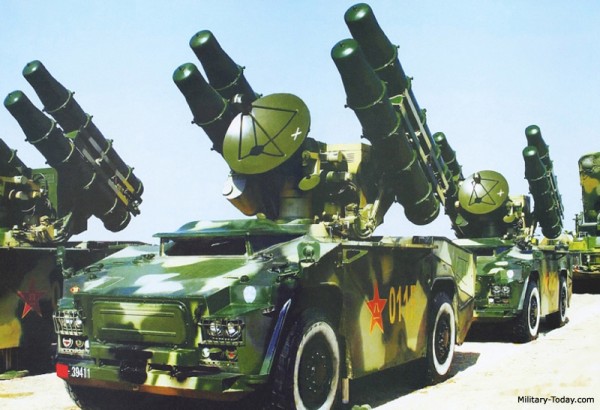
HQ-7 Crotale
In 2009, China demonstrated their investment in modern weapons technology in their National Military Day parade. Several new weapons systems were developed under the radar and the 2009 parade brought them into view. In the past, technology was purchased and adapted from Soviet eras weapons systems and often remained in operation within China. The 60s and 70s showed Chinese weapons systems exported to places like Vietnam and North Korea. The 1991 Gulf War put many Chinese systems developed from original Soviet designs at the front of the line. These Chinese tanks and APCs were often destroyed by allied armour and airstrikes. These experiences lead Chinese engineers to design wholly indigenous systems.
China recently became the world’s 3rd largest exporter of weapons systems behind the US and Russia. Many of these weapons are finding their way to the Middle East and Pakistan, the latter having some joint weapons development programs with China. While analysts are concerned with Stealth fighters, Ballistic missile systems and chemical weapons proliferation, the distribution of artillery and anti-aircraft systems will likely have a larger effect on the political and defensive environment in many of the purchasing countries than WMDs. The 2009 parade introduced many artillery systems that were designed to counter Western heavy weapons systems. While shoulder launched systems have already lead to several causalities in Syria and Iraq, heavy weapons systems like the 2S19 MSTA style PLZ-05 and PLZ-07 long range artillery system are some of the most modern artillery systems on the field. New types of Rocket Artillery from the 2009 parade also made an appearance, designed to match the capabilities of the Russian Uragan and Smerch, devastating entire areas of the battlefield in their use.
Weapons systems from China that will likely make the news in any modern conflict are mostly designed to shoot down enemy aircraft as well as cruise missiles. A traditional anti-aircraft system that has been exported since the 1980s is based on the French Crotale missile system. The Chinese HQ-7 Crotale was one of the first modern and mobile Chinese licensed systems. Other licensed systems from Russia like the Chinese version of the Russian SA-15 Tor-M1 and S-300 are some of the most accurate systems in the world today. To accompany their missile systems, China developed the indigenous PGZ-95 system, a Tunguska type vehicle with four anti-aircraft cannons and four missiles of the shoulder launched type. New missile systems developed and demonstrated in the 2009 parade are the HQ-61A, HQ-12, HQ-16 and HQ-64, modern systems that match the capabilities of their Russian counterparts but are not well known by Western intelligence experts.
China currently makes up about 5% of world arms exports, slightly beating out Germany and France. Pakistan, Bangladesh and Myanmar receive a large portion of these exports and China’s weapons exports are likely to grow. Being less tied to political limitations like systems from the US and Europe and adapting technology to produce less expensive versions of Russian systems will likely get China many export sales. It is a prudent response for countries countering Chinese systems in the future to become more familiar with their capabilities and effects. There is a good chance that many of these weapons systems will become significant in future conflicts, if not already the case.